Freelancing means working independently for different clients rather than being tied to a single employer. It allows you to offer your skills directly to those who need them, giving you control over your work, schedule, and income. This flexibility appeals to many people looking to start their own careers or supplement their current jobs.
Starting as a freelancer might seem overwhelming, especially if you lack experience. However, by choosing a niche, building a portfolio, and using online platforms to find work, you can begin taking on projects with confidence. The process is simple but requires consistent effort and learning to establish yourself.
I understand the challenge of breaking into freelancing because I’ve been there. This guide will give you clear steps and practical advice to help you get started without unnecessary complications.
What Is Freelancing?
Freelancing is a flexible way of working that allows individuals to offer their skills independently. It involves engaging with clients directly or through platforms, often on a project or contract basis. Understanding the core aspects of freelancing helps to determine if it suits your career goals.
Definition of Freelancing
Freelancing means working for yourself rather than being employed by one company. I see it as providing specific services or skills to multiple clients, usually remotely. You negotiate terms, deadlines, and payment independently.
This work is typically project-based and temporary. Instead of a fixed salary, I earn through contracts or gigs. Freelancers manage their own taxes, schedules, and client relationships. It offers freedom but requires self-discipline and business skills.
Types of Freelance Work
Freelance jobs span many fields, such as:
- Writing and editing
- Graphic design
- Web and software development
- Marketing and social media management
- Consulting
- Photography and video production
I can choose specialties based on my skills and interests. Work often varies by project, allowing me to build diverse experience. Certain platforms focus on specific industries, making it easier to find relevant clients.
Key Traits of a Freelancer
To succeed, I need self-motivation and strong time management. Without a traditional employer, I set deadlines and stay productive independently.
Good communication is crucial. I must clearly discuss expectations and progress with clients. Adaptability helps me handle different projects and client demands.
Finally, discipline in handling finances and marketing myself is essential. Freelancing requires both skill mastery and business awareness to grow steadily.
How Freelancing Works
Freelancing involves managing your own schedule, clients, and payments. It differs from traditional jobs by offering more independence but requires handling tasks usually managed by employers. Understanding the core differences, common work models, and client relationships sets the foundation for getting started.
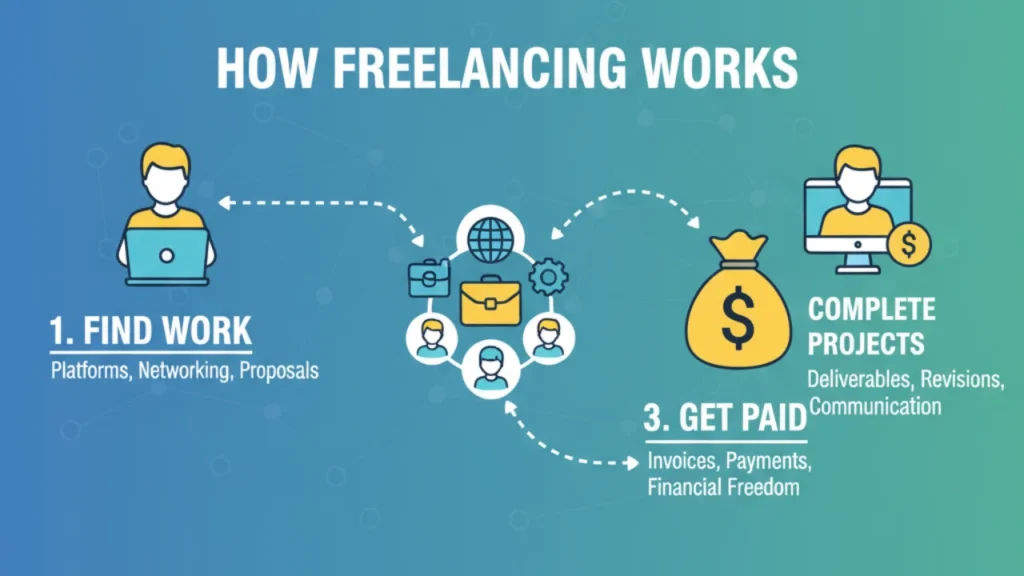
Freelancer vs. Traditional Employment
Unlike traditional employment, freelancing means I am self-employed. I don’t have a fixed salary or regular work hours. Instead, I get paid per project, hour, or task.
There is no guaranteed income since I must find clients and negotiate rates myself. I handle my own taxes, benefits, and business expenses. This gives me flexibility but also adds responsibility for everything related to my work.
I am not tied to a single company. I can work with multiple clients at once or take breaks between contracts. This contrasts with employees who usually have long-term commitments and fixed roles.
Common Freelancing Models
I usually work under three main models:
- Project-based: Paid a flat fee for completing a specific project.
- Hourly: Paid based on hours worked on tasks or projects.
- Retainer: Paid a fixed monthly amount to be available for ongoing work.
Each model has pros and cons. Project-based work offers clear deliverables but requires accurate estimates. Hourly work ensures payment for time but may limit income growth. Retainers provide steady income but need ongoing availability.
I choose the model depending on the client’s needs and the type of work, such as writing, design, or programming.
Freelancer-Client Relationships
Managing client relationships is crucial. I must clearly define work scope, deadlines, and payment terms upfront to avoid disputes. Contracts or written agreements help formalize this.
I communicate regularly to update on progress and handle feedback. Building trust and professionalism increases chances of repeat business.
Since I’m independent, I’m responsible for marketing myself, negotiating rates, and resolving issues. This autonomy requires strong organization and communication skills but allows me control over my career.
Benefits of Becoming a Freelancer
Freelancing offers unique advantages that can shape how I work and live. From controlling my schedule to expanding my ways to earn, these benefits make freelancing appealing for various reasons. I focus on what truly impacts my career and personal life.
Flexibility and Independence
One of the biggest benefits I value is flexibility. I decide when and where to work, which means I can fit projects around my personal commitments. This independence removes the constraints of traditional office hours.
I’m also free to choose clients and projects that match my skills and interests. This control helps me avoid monotonous tasks and pursue work that feels meaningful. Managing my workload allows me to prevent burnout and maintain better focus.
Diverse Income Opportunities
Freelancing opens multiple income streams. I don’t rely on a single employer but can work with many clients simultaneously, reducing financial risk. This diversity allows me to explore different industries and services.
I can set my own rates based on the complexity and value of my work. This control over pricing often leads to higher earnings than fixed salaries. Freelancing also offers the chance to grow earnings by expanding skills or taking on more projects.
Work-Life Balance
Managing my own schedule makes it easier to balance work and personal life. I can prioritize important events or take breaks when needed without asking for permission, which is a significant advantage.
This control over time reduces stress and improves productivity. I’m able to design a work routine that fits my lifestyle, whether that means working early mornings, late nights, or in focused bursts. It supports both my professional goals and wellbeing.
Challenges of Freelancing
Freelancing requires handling uncertainty, juggling various tasks, and maintaining strong personal discipline. These aspects create hurdles that must be addressed to build a sustainable freelance career.
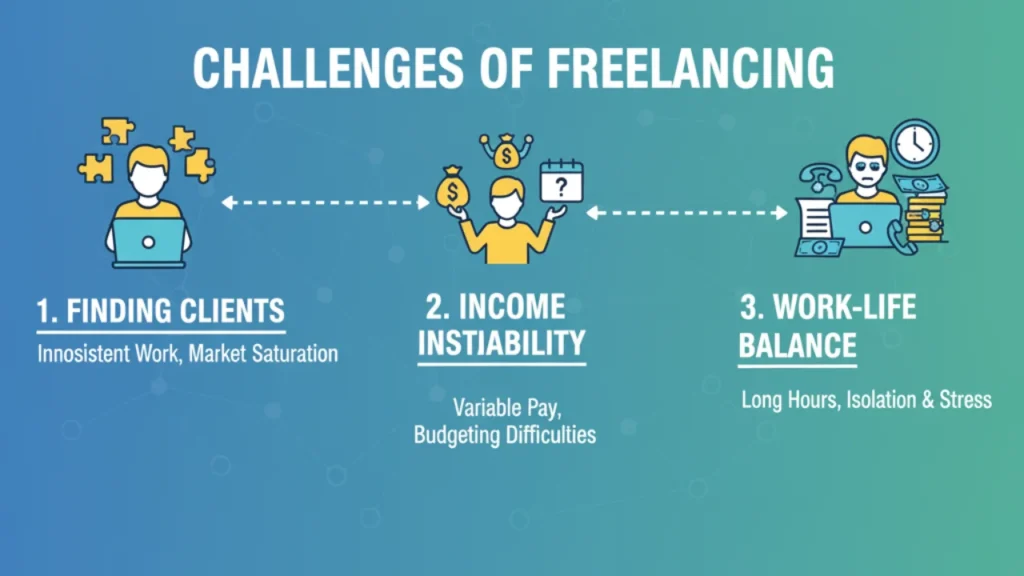
Income Stability
One of the main challenges I faced was managing uneven income. Unlike a regular paycheck, freelancing payments vary depending on client workload and project timelines. This can make budgeting difficult.
To handle this, I track my expenses meticulously and build a financial buffer to cover months with fewer projects. Setting clear payment terms and upfront deposits also helps reduce late payments and cash flow issues.
Having multiple income streams within freelancing—such as combining short-term gigs with long-term contracts—can offer more stability, but it takes time to establish.
Managing Multiple Clients
Working with several clients simultaneously demands strong organization and communication. I had to develop systems for tracking deadlines, deliverables, and client expectations to avoid confusion.
I use tools like calendars, task managers, and shared documents to keep everything transparent and on schedule. Regular updates ensure clients feel informed and reduce last-minute changes.
Balancing client demands requires careful time allocation. I prioritize urgent and high-value projects first, while setting realistic boundaries to prevent overload.
Self-Motivation Requirements
Freelancing places the responsibility for productivity entirely on me. Without supervisors or fixed schedules, staying motivated daily can be challenging, especially during slow periods.
I set clear goals and daily routines to maintain focus. Breaking tasks into smaller steps helps me avoid feeling overwhelmed and encourages steady progress.
Creating a dedicated workspace and minimizing distractions also improve my ability to work independently. Accountability through personal deadlines or peer check-ins keeps me on track.
How to Start Freelancing as a Beginner
Starting freelancing requires defining what you offer, preparing a way to show your work, and creating profiles where clients can find you. Each of these steps builds a solid foundation to attract and secure freelance projects.
Identifying Your Skills and Services
I began by listing all my skills, both technical and soft, and considering which ones solve common problems. This helps narrow down services I can confidently provide, like writing, design, or coding.
It’s important to focus on skills in demand. For example, web development, content creation, and graphic design tend to have steady freelance opportunities. I ranked my skills by proficiency and market relevance to decide what to offer first.
I also defined clear service offerings. Instead of vague “design work,” I specify things like logo creation, social media graphics, or website layouts. This clarity helps potential clients quickly understand what I do.
Building an Online Portfolio
My portfolio is a collection of my best work that proves my abilities. Even if I lacked paid projects initially, I created samples or did small projects for friends or nonprofits.
I use simple, clean website builders like Wix or WordPress to showcase my portfolio. Each piece includes a brief description focusing on the goal, tools used, and outcomes.
Organizing projects by type or industry improves usability. Including testimonials and clear contact info also strengthens credibility. The goal is making it easy for clients to see my skills and decide to hire me.
Setting Up Professional Profiles
Creating profiles on platforms like Upwork, Fiverr, or LinkedIn was essential for me to reach clients. I filled in every section carefully, emphasizing skills, experiences, and the services I offer.
I keep my profile photo professional and write a summary focusing on how I solve client problems. Adding relevant keywords helps my profile appear in search results.
I also set competitive rates based on research within my niche and gradually increased them as I gained experience. Having multiple profiles helps diversify client sources, but I maintain consistency in information and branding across platforms.
Finding Freelance Jobs
Finding freelance jobs requires targeted effort using multiple approaches. I focus on platforms with established client bases, building real connections through networking, and crafting pitches that clearly communicate value.
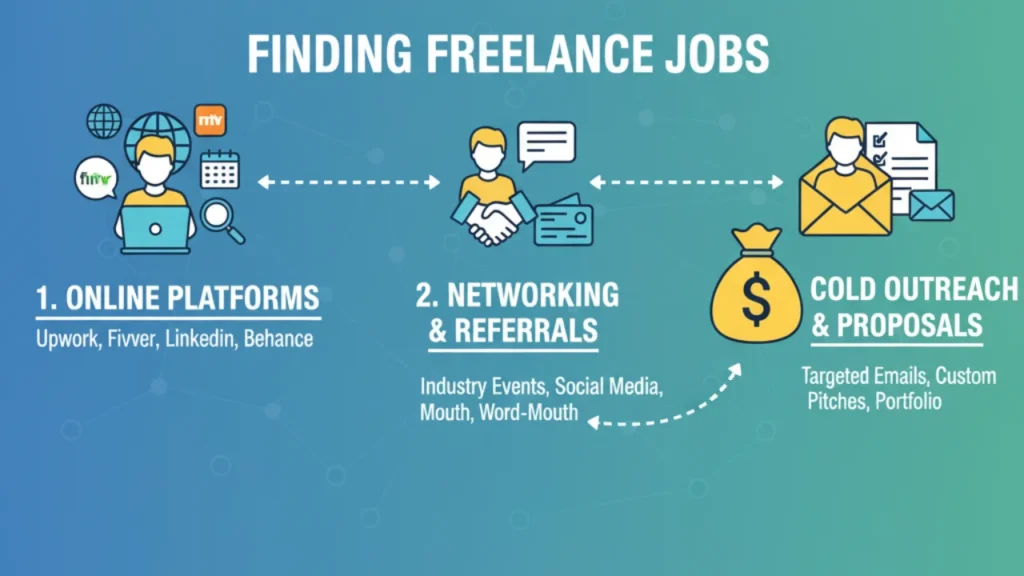
Popular Freelance Platforms
I use well-known platforms like Upwork, Fiverr, and Freelancer to find freelance jobs. These sites offer a variety of categories and allow me to build a profile showcasing my skills and past work. Each platform charges fees, so I factor that into my pricing.
Choosing the right platform depends on the type of work I want. Upwork tends to have longer projects, while Fiverr suits quick gigs. I always read client reviews and job details carefully before applying to ensure the opportunity matches my skills.
Networking Strategies
Networking is essential for discovering freelance work outside platforms. I attend industry meetups, join professional groups on LinkedIn, and participate in online communities related to my field. These connections often lead to referrals or direct client inquiries.
I also reach out to past colleagues and clients to let them know I am available for freelance projects. Consistently showing interest and offering value during conversations helps me stay top of mind.
Pitching to Potential Clients
When pitching, I tailor my proposals to the specific needs of each client. I clearly explain how my skills solve problems or improve their business. I keep my message direct and focus on delivering results rather than generic promises.
I include relevant samples and follow up politely if I don’t hear back. A strong, personalized pitch increases my chances of winning contracts.
Setting Your Rates and Managing Payments
Setting your freelance rates and managing payments carefully is essential for a sustainable business. This involves determining the right pricing structure, handling contract discussions effectively, and choosing the most secure and efficient payment methods.
How to Price Your Services
When I price my services, I first calculate all monthly expenses, including both personal needs and business costs such as equipment, software, and taxes. From there, I decide whether to charge hourly, per project, or use value-based pricing depending on the type of work and client expectations.
Hourly rates require me to estimate how many billable hours I can realistically work, factoring in breaks and non-billable tasks. For project-based pricing, I outline the scope clearly to avoid scope creep. Value-based pricing lets me charge based on the results I deliver, not just time spent.
I recommend researching competitors and the industry standard rates for my field. This helps ensure that my prices are competitive but still cover my costs and desired profit.
Negotiating Contracts
Negotiating contracts is about clear communication and setting expectations upfront. I make sure to specify deliverables, deadlines, payment terms, and revision limits in writing before starting a project.
When discussing rates, I remain firm on my minimum fees but stay open to reasonable client requests. I also clarify any additional costs that might arise and how those will be handled.
Using written contracts or agreements protects both me and the client. It helps prevent misunderstandings and gives a professional framework to refer back to if disputes occur. I always advise requesting a deposit upfront to secure the project.
Invoicing and Payment Methods
For invoicing, I use templates that include essential details like my name, contact information, the client’s details, a breakdown of services, and payment due dates. Clear, professional invoices speed up payment processing.
I prefer using online payment methods such as PayPal, bank transfers, or payment platforms tailored for freelancers. These options offer convenience, faster transactions, and tracking capabilities.
I also set clear payment terms, typically requiring payment within 15 to 30 days after invoice submission. If delays occur, I follow up promptly but professionally to maintain good client relationships while ensuring timely compensation.
Essential Tools and Resources for Freelancers
To run a freelancing business effectively, I rely on tools that help me manage my time, track finances, and organize projects. Having the right software saves time and reduces errors, which are critical when working independently.
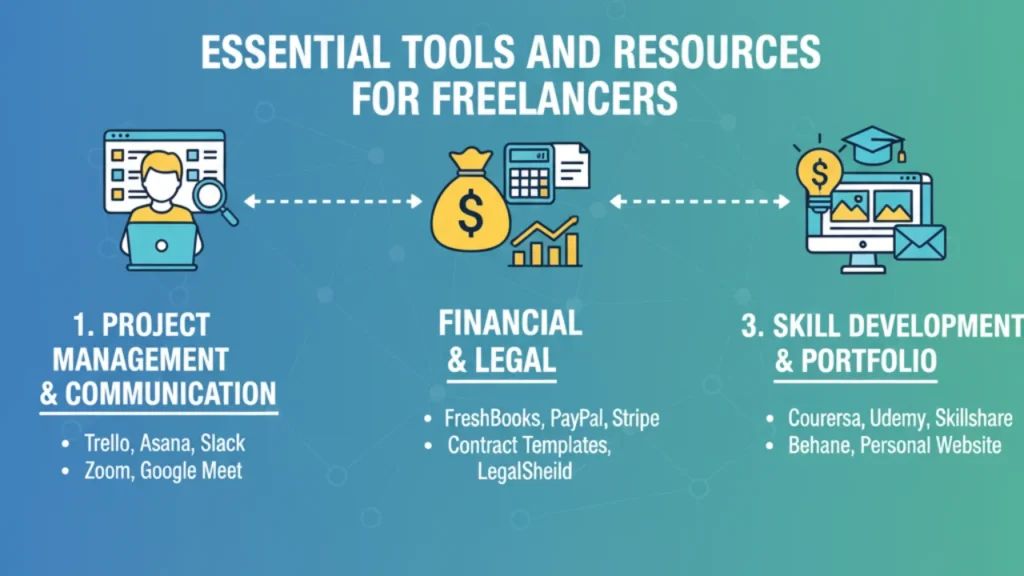
Productivity and Time Management Tools
I use time tracking apps to monitor how long tasks take, helping me stay focused and bill accurately. Tools like Toggl and Clockify are straightforward, offering timers and detailed reports.
To boost productivity, I also use task managers such as Todoist or Microsoft To Do. These help me prioritize work and break down larger projects into manageable steps.
Automated reminders and scheduling tools like Google Calendar keep me on track for deadlines and meetings. These integrations reduce the risk of missed appointments or overdue tasks.
Accounting and Expense Tracking
Handling my finances properly is essential to avoid surprises during tax season. I use accounting software like QuickBooks Self-Employed or FreshBooks to track invoices, expenses, and payments automatically.
These tools generate professional invoices quickly and send payment reminders to clients. They also categorize expenses, making tax deductions easier to identify.
By linking bank accounts, I can monitor cash flow in real-time. Regular financial record keeping ensures I maintain control over my budget and plan for upcoming tax payments.
Project Management Systems
To manage multiple projects, I rely on platforms like Asana, Trello, or ClickUp. These systems allow me to create project boards that outline tasks, deadlines, and progress clearly.
Collaboration features let me communicate with clients or team members directly within the project. This centralizes feedback and reduces reliance on scattered emails.
I set milestones and use visual tools like Gantt charts to keep long-term projects on schedule. This organized approach helps me deliver quality work consistently while juggling several jobs.
Legal and Tax Considerations for Freelancers
Starting freelancing means managing several legal and tax responsibilities. It’s important to understand how to formally set up your business, handle your tax obligations, and protect your work with legal agreements.
Registering Your Business
You don’t need to register a separate legal entity to start freelancing. Many begin as sole proprietors without filing special paperwork. However, registering as an LLC or other business type can provide liability protection and potential tax advantages.
Check if your city or state requires any permits or business licenses. Some locations mandate registration or local taxes for freelancers. For example, New York City requires freelancers working in the city to pay city income tax.
I recommend registering a business name if you want to operate under a different name than your legal one. This process, called a “Doing Business As” (DBA), formalizes your freelance brand without creating a new legal entity.
Understanding Taxes and Deductions
Freelancers are responsible for paying federal, state, and sometimes local income taxes. You must also pay self-employment tax, which covers your Social Security and Medicare contributions.
I make quarterly estimated tax payments to avoid penalties. These are based on projected income and expenses. You have to report all income accurately, whether it comes from one client or many.
Taking advantage of tax deductions is essential. Common deductions include home office expenses, software subscriptions, equipment, travel, and part of your phone or internet bills. Keeping detailed records and receipts for these expenses is critical for accurate filing and audits.
Protecting Your Work with Contracts
Contracts protect both you and your clients by clearly defining the project scope, deliverables, deadlines, rates, and payment terms.
I always use written contracts before starting work. This lowers the risk of misunderstandings or non-payment. Contracts should also address intellectual property rights so it’s clear who owns the work after completion.
If you’re unsure what to include, templates created for freelancers can be a helpful starting point. Consulting a legal professional to review or customize your contracts is a good investment as your business grows.
Tips for Long-Term Success in Freelancing
Consistency and ongoing effort are essential to sustain a freelance career. It requires establishing a clear presence, expanding your skills continuously, and nurturing positive connections with clients for repeat work.
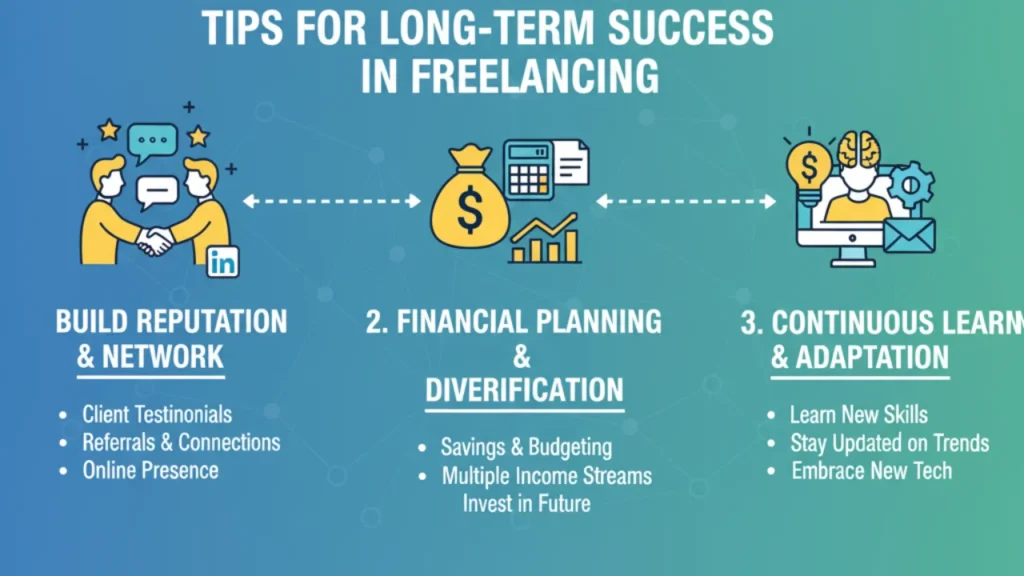
Building a Personal Brand
Your personal brand defines how clients perceive you. I focus on creating a professional online presence through a well-crafted portfolio and active profiles on platforms relevant to my skills.
Clear communication and consistent delivery of quality work build trust. I use a logo, specific color schemes, and a professional tone to make my profile recognizable.
Sharing client testimonials and case studies strengthens credibility. Being visible on social media or industry forums helps me stay connected with potential clients and peers.
Continuous Skill Development
Freelancing demands staying updated with industry trends and tools. I allocate time regularly to learn new techniques or improve existing skills through courses, webinars, or reading.
I prioritize skills that directly enhance my offerings or differentiate me in the market. For example, if I’m a writer, learning SEO or different content formats adds value to my services.
Tracking progress is key. I set clear goals for skill acquisition and review them quarterly to ensure I keep pace with client needs and market changes.
Maintaining Client Relationships
Strong client relationships lead to repeat business and referrals. I maintain regular communication and deliver projects on or ahead of schedule.
Following up with clients after project completion shows professionalism. I also ask for feedback and adjust my work accordingly.
Transparency is important. I discuss timelines, costs, and expectations explicitly to avoid misunderstandings. Reliable responsiveness builds my reputation as a dependable freelancer.

I created this website to share practical guides, tips, and resources that help people build digital skills, explore freelancing, grow their careers, and discover new ways to earn online.

